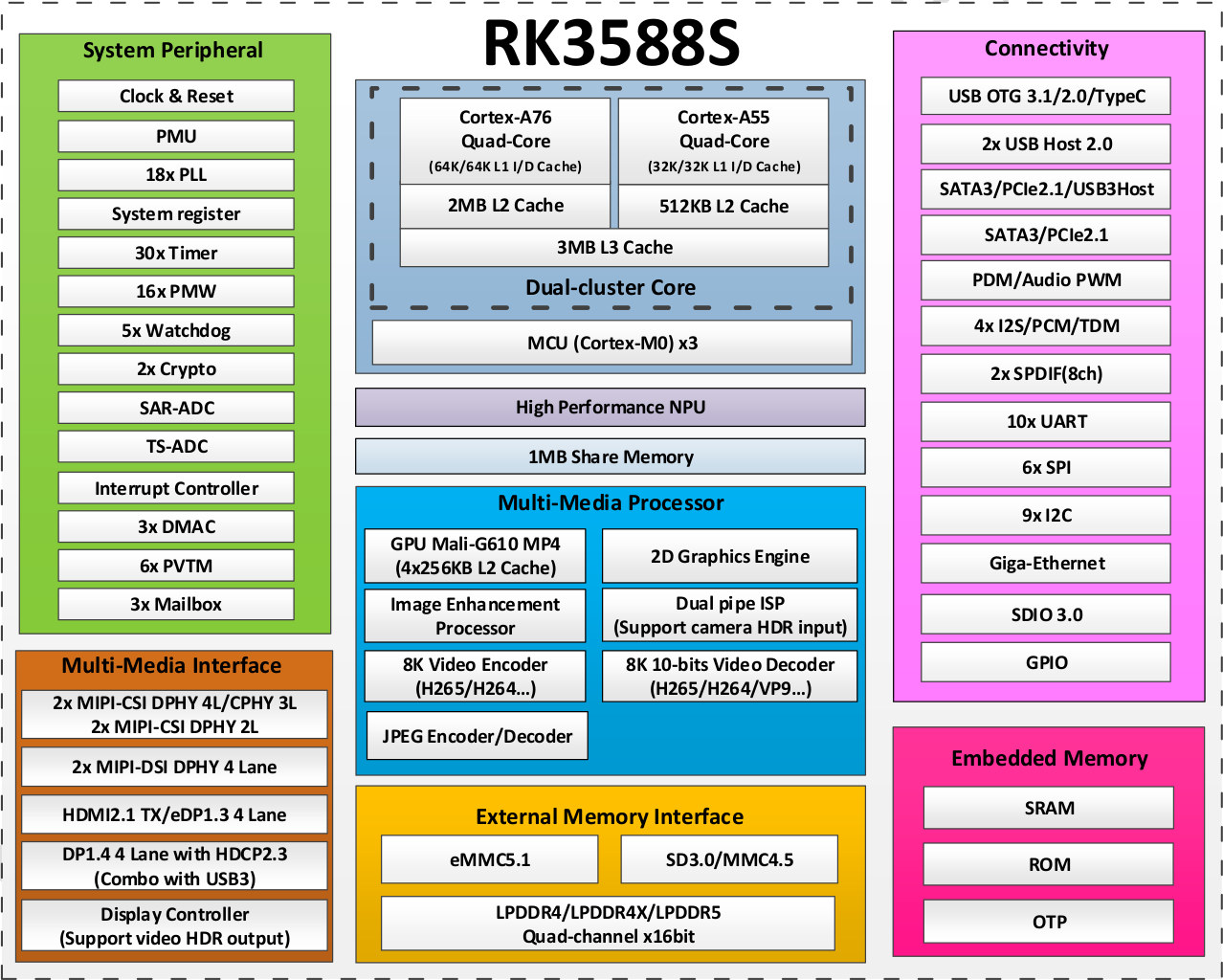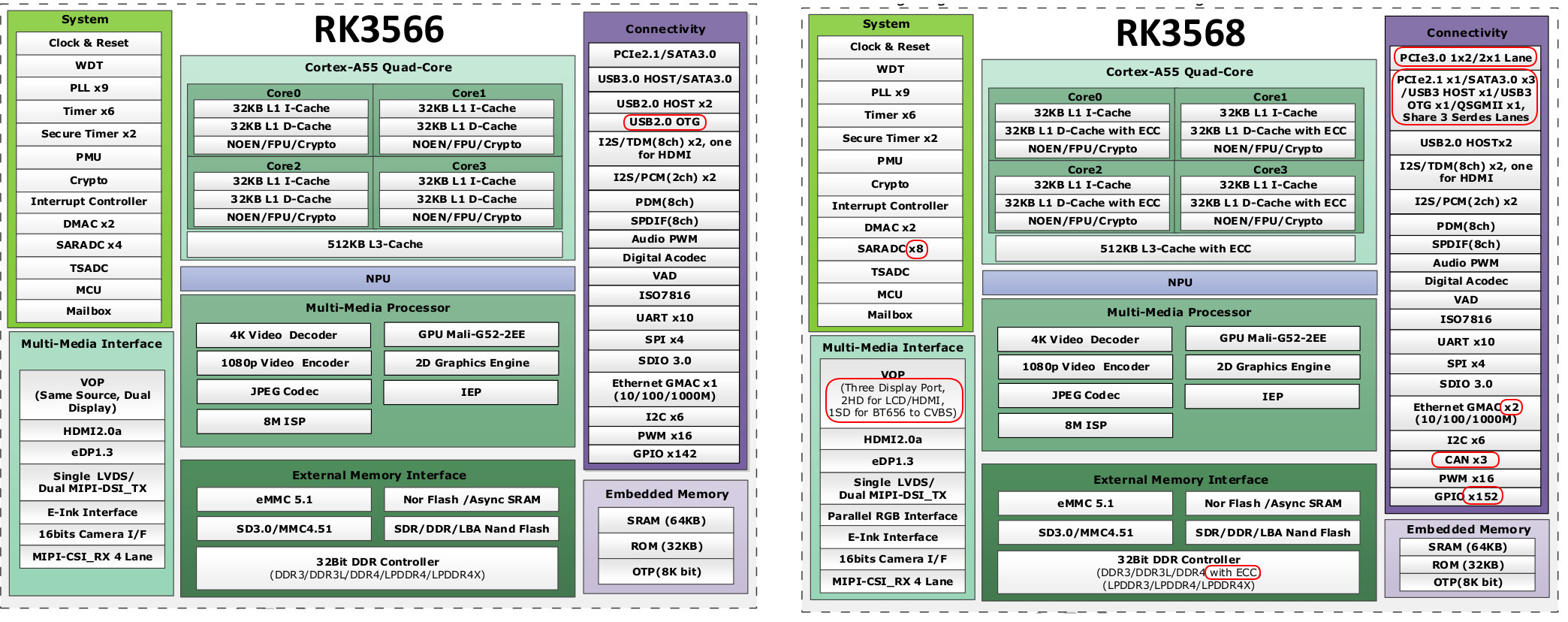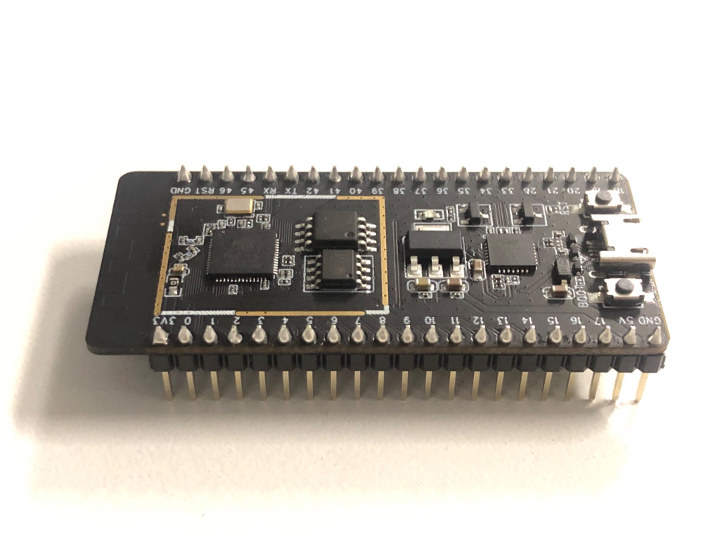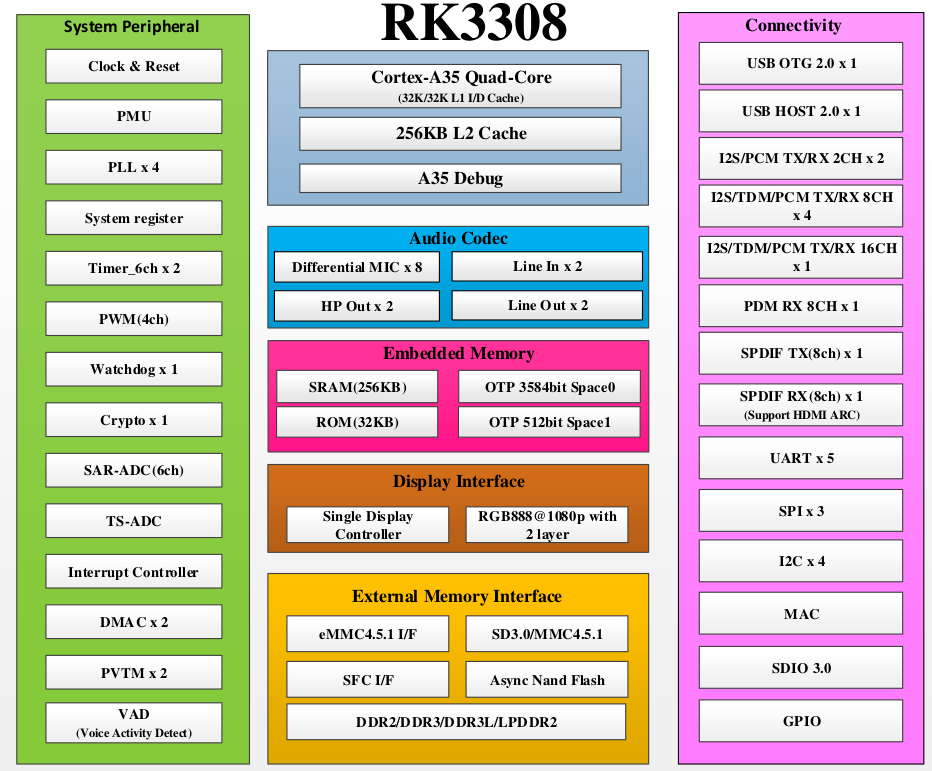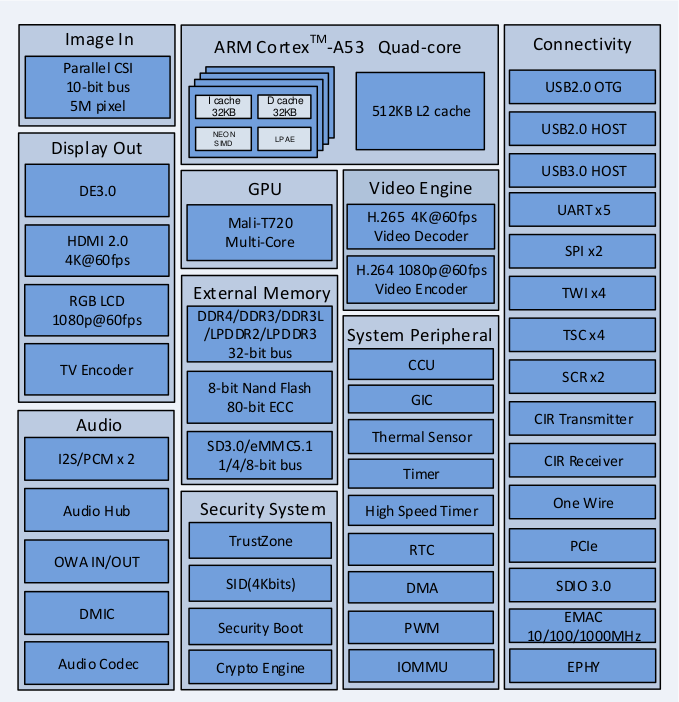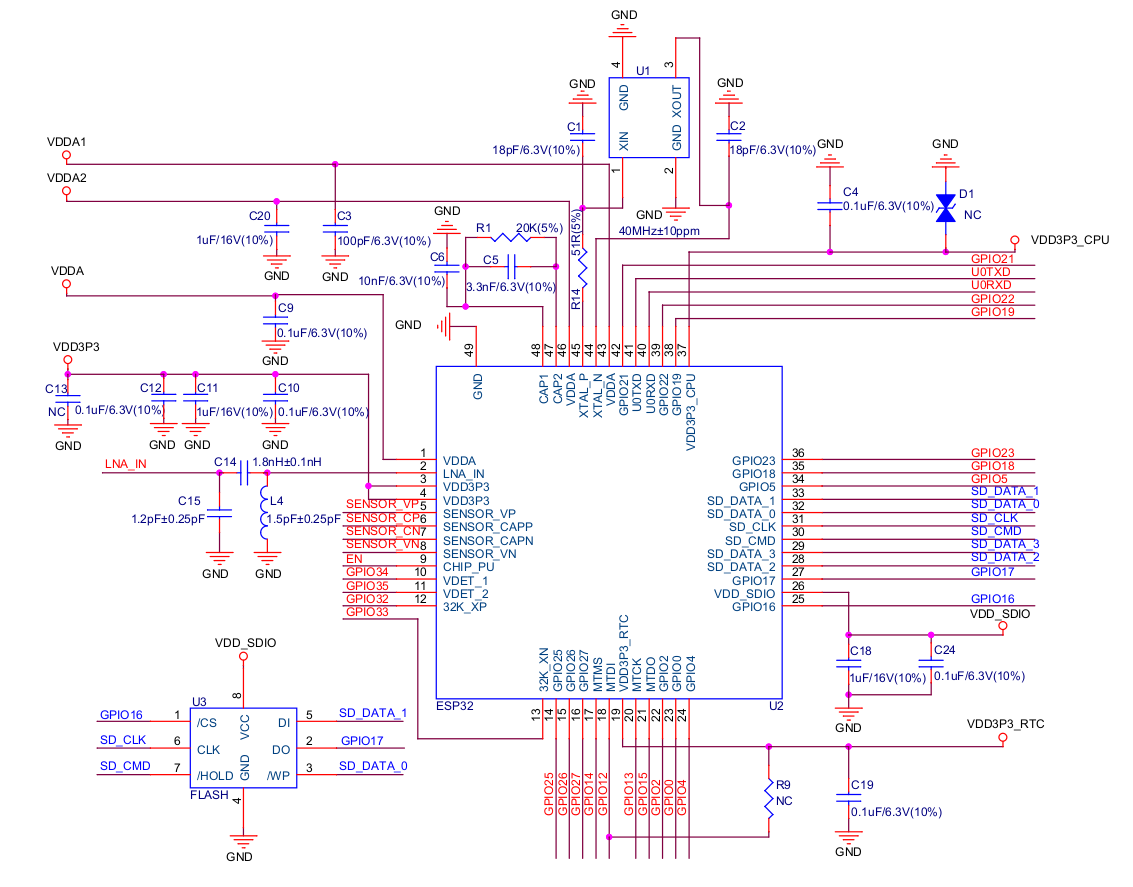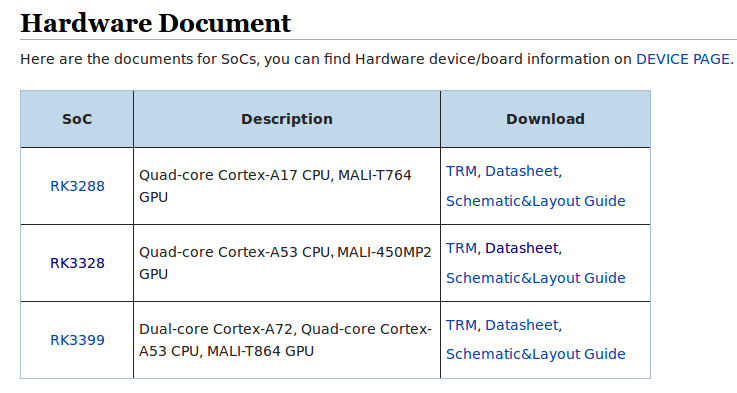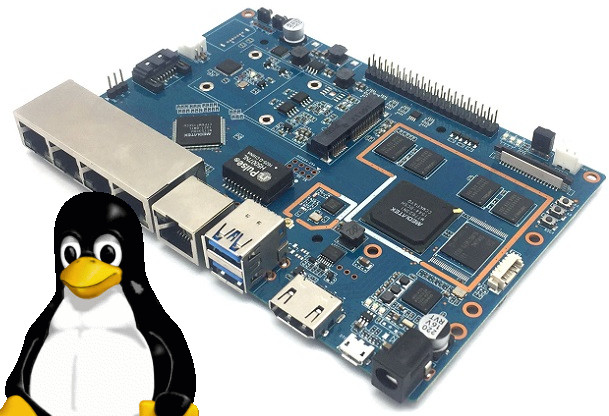Rockchip RK3588S is a cost-optimized version of the RK3588 octa-core Cortex-A76/A55 processor with fewer peripherals, and I’ve been told it’s been designed for tablets, but as we’ll see below, the processor will probably find its way into many other applications. We first saw RK3588S during the Rockchip Developer Event last December, but at the time we did not have any information, except it would be a lower-cost version. I’ve now received an RK3588S datasheet, so let’s have a look at the block diagram and specifications to find out what’s different. Rockchip RK3588S specifications with highlights in bold showing the differences against RK3588: CPU – 4x Cortex-A76 and 4x Cortex-A55 cores in dynamIQ configuration GPU Arm Mali-G610 MP4 “Odin” GPU with support for OpenGLES 1.1, 2.0, and 3.2, OpenCL up to 2.2 and Vulkan1.2 2D graphics engine up to 8192×8192 source, 4096×4096 destination AI Accelerator – 6 TOPS NPU 3.0 (Neural […]
Rockchip RK3566 and RK3568 datasheets and features comparison
We first covered Rockchip RK3566 processor in February, but we’ve been informed the specifications have changed since then, and earlier this month, we also wrote about RK3568 quad-core Cortex-A55 processor with the same base features but some extra I/Os. But due to NDAs, people familiar with the chips could not release too many details, so we did not get the full picture. This has just changed as the datasheets for both processors have just dropped from somewhere here and there, and we can get a much closer look. RK3566 and RK3568 specifications I’ve highlighted the obvious differences above, with the big ones being the PCIe interface and RK3568 having dual Gigabit Ethernet. The other features comparison can be found in the table below. Multiplexed interfaces. Important note. Rockchip RK3566 and RK3568 are using Multi-PHY Interfaces, and while the table above lists all possible interfaces, they can not all be used […]
ESP32-S2 Processor Datasheet Released, Development Boards Unveiled
Last may Espressif Systems unveiled ESP32-S2 secure WiFi processor with a single Xtensa LX7 core clocked at 240 MHz, and the first ESP32 processor to come with a built-in USB (OTG) interface, as well as some new features such as WiFi Time-of-Flight (ToF), hardware security, LCD RGB & camera interfaces, and more. Note that contrary to other ESP32 processors launched so far, ESP32-S2 does not support Bluetooth. ESP32-S2 Datasheet The processor is still not available, but there has been some interesting development in recent weeks. First the datasheet (PDF) has been released, so we’ve got to check more technical details including the processor diagram below. The main specifications have not changed, so I won’t reproduce them here, and you can check out ESP32-S2 announcement for specs. ESP32-S2 Development Boards The first ESP32-S2 development boards are also available… in Espressif Systems’ offices that is, but not quite publicly. The board above […]
Rockchip RK3308 & RK3326 Datasheets Released
Rockchip unveiled their first Arm Cortex-A35 processors with RK3326 “Gemini” and RK3308 SoCs last March. Both are designed for Smart AI solutions, and the company showcased two development kits for smart speakers and smart displays based on the new processors. We’ve already known the basic details for the processors for some times, with for example RK3326 featuring a Mali-G31 Dvalin GPU, but I’ve now been informed more details have surfaced since Rockchip published documentations including datasheets. Rockchip RK3308 Key features and specifications: CPU – Quad-core Arm Cortex-A35 64-bit Armv8-A CPU with NEON, ARMv8 Cryptography Extensions, 256KB unified system L2 cache, and VFPv4 FPU, System Memory – 256KB internal SRAM, support for DDR2, DDR3/DDR3L, LPDDR2 external memory up to 512MB Storage Internal BootROM OTP – Support 4K bit Size, 3.5K bit for secure application External I/F – 8-bits Asynchronism Nand Flash, eMMC 5.1, SPI Nor/Nand Flash, SD Card all bootable; System […]
Allwinner H6 Datasheet and User Manual Released
Putting aside the ill-fated Allwinner A80 SoC, Allwinner H6 is the first Allwinner processor with multiple high speed interfaces such as Gigabit Ethernet, USB 3.0 and PCIe, and also support 4K HDR with the company’s Smart Color Engine for video processing. So far, it’s been found in some 4K HDR TV boxes such as Zidoo H6 Pro or Beelink GS1. We’ve already known Shenzhen Xunlong was working on Orange Pi 3 Plus board with the processor for a few months, but Pine64 appear to have joined the party, and will soon launch Pine64 H64 board according to their Wiki. No photos yet, but the company released various documents for the board including Allwinner H6 V200 datasheet (80 pages), and Allwinner H6 V200 user manual (965 pages). The documents should – for instance – allow sunxi-linux community to port drivers for the processor. Some corrections have been made to the first […]
ESP32-PICO-D4 System-in-Package Combines ESP32, 4MB SPI Flash, a Crystal Oscillator, and Passive Components
Espressif Systems has revealed another ESP32 variant, but this time it’s not an SoC, but a 7x7mm system-in-package (SIP) that comes ESP32 dual core processor, a 4MB SPI flash, a crystal oscillator and various passive components, so that you don’t need to include those in your design, and create an ultra-compact PCB for wearables and other space-constrained applications. ESP32-PICO-D4 SiP specifications: SoC – ESP32 with two Tensilica LX6 cores, 448 KB ROM, 520 KB SRAM (inc. 8KB RTC memory), 1kbit eFuse On-module Flash – 4MB SPI flash Connectivity WiFi – 802.11 b/g/n/e/i (802.11n up to 150 Mbps) Bluetooth – Bluetooth V4.2 BR/EDR and BLE specification; ; class-1, class-2 and class-3 transmitter; Audio: CVSD and SBC SIP Interfaces SD card, UART, SPI, SDIO, LED PWM, Motor PWM, I2S, I2C, IR GPIO, capacitive touch sensor, ADC, DAC, LNA pre-amplifier Sensors – On-chip Hall sensor & temperature sensor Clock – On-module 40 MHz crystal […]
Rockchip Has Setup an Official Open Source Website with Software & Hardware Documentation, Source Code
As a young engineer, I first understood the importance of good documentation thanks to an incomplete Holtek MCU datasheet that made us waste weeks of development, and the value open source software thanks to Sigma Designs’ SDK that was full of binary blobs with our applications often crashing inside those, leading to software development delays, especially since we had access to limited support. More recently, if you ever worked with the most popular Chinese processors found in ARM Linux development board, usually made by Allwinner, Amlogic, or Rockchip, you must have gone through roadblocks due to a lack of documentation and software support. So far, Allwinner is purely relying on linux-sunxi community and “leaks” of their documentation and SDKs, while Amlogic has had their “open linux” microsite for several years, but you won’t find complete documentation like technical reference manual, schematics, and part of the source code requires you to […]
Banana Pi BPI-R2’s U-boot & Linux 4.4 Source Code & MediaTek MT7623N Datasheet Released
Banana Pi BPI-R2 is a multimedia router board powered by MediaTek MT7623N quad core processor with 2GB RAM, 5 Gigabit Ethernet ports, up to two SATA ports, two USB 3.0 ports, HDMI output, and I/O headers. The board is not for sale yet, but the company has recently released the source code with U-boot and Linux 4.4.70, as well as a datasheet for MediaTek MT7623N processor. The source code can be found on Github, so let’s see if we can build it:
|
1 2 3 4 5 6 7 8 9 10 11 12 13 14 15 16 17 18 19 20 21 22 23 |
git clone https://github.com/BPI-SINOVOIP/BPI-R2-bsp cd BPI-R2-bsp/ sudo apt install gcc-arm-linux-gnueabihf ./build.sh ./build.sh NOTICE: new build.sh default select BPI-R2-720P and pack all boards supported boards: BPI-R2-720P BPI-R2-720P configured. Now run `make` This tool support following building mode(s): -------------------------------------------------------------------------------- 1. Build all, uboot and kernel and pack to download images. 2. Build uboot only. 3. Build kernel only. 4. kernel configure. 5. Pack the builds to target download image, this step must execute after u-boot, kernel and rootfs build out 6. update files for SD 7. Clean all build. -------------------------------------------------------------------------------- Please choose a mode(1-7): 1 |
After a couple of minutes, the build would end with:
|
1 2 3 4 5 |
usr/lib/u-boot/bananapi/ usr/lib/u-boot/bananapi/bpi-r2/ usr/lib/u-boot/bananapi/bpi-r2/BPI-R2-720P-2k.img.gz Build success! |
For the very last step, it asks you to login as root / sudoer, which it should not do… But we end up with the images, so at least it builds:
|
1 2 3 4 5 6 7 8 |
ls -lh ./SD/ total 27M drwxrwxr-x 2 jaufranc jaufranc 4.0K Jun 28 10:46 100MB -rw-rw-r-- 1 jaufranc jaufranc 22M Jun 28 10:46 4.4.70-BPI-R2-Kernel.tgz -rw-rw-r-- 1 jaufranc jaufranc 151K Jun 28 10:46 BOOTLOADER-bpi-r2.tgz drwxrwxr-x 3 jaufranc jaufranc 4.0K Jun 28 10:46 BPI-BOOT -rw-rw-r-- 1 jaufranc jaufranc 4.8M Jun 28 10:46 BPI-BOOT-bpi-r2.tgz drwxrwxr-x 4 jaufranc jaufranc 4.0K Jun 28 10:46 BPI-ROOT |
MediaTek has also been active by committing patchsets for MT7623 to the Linux Kernel Mailing List, so mainline Linux is an eventual possibility for […]


